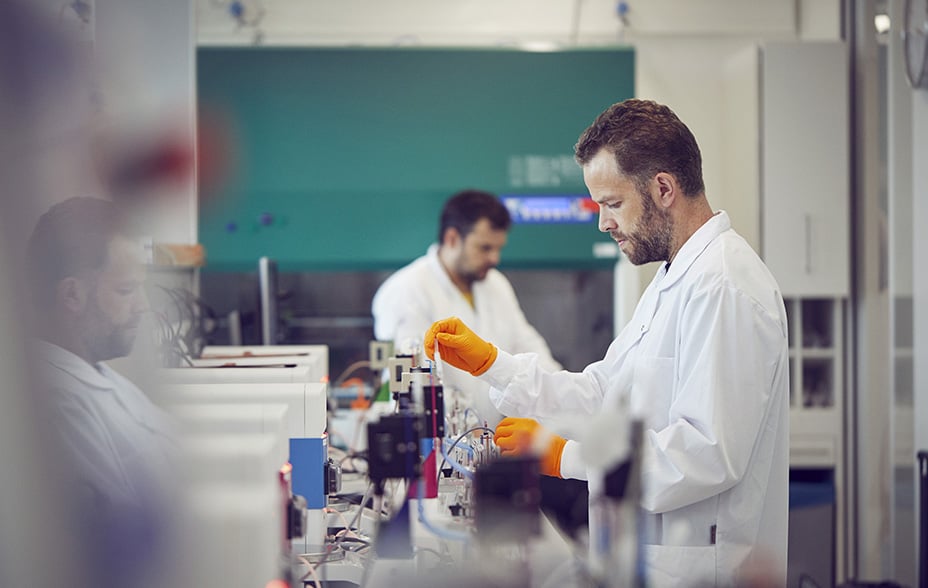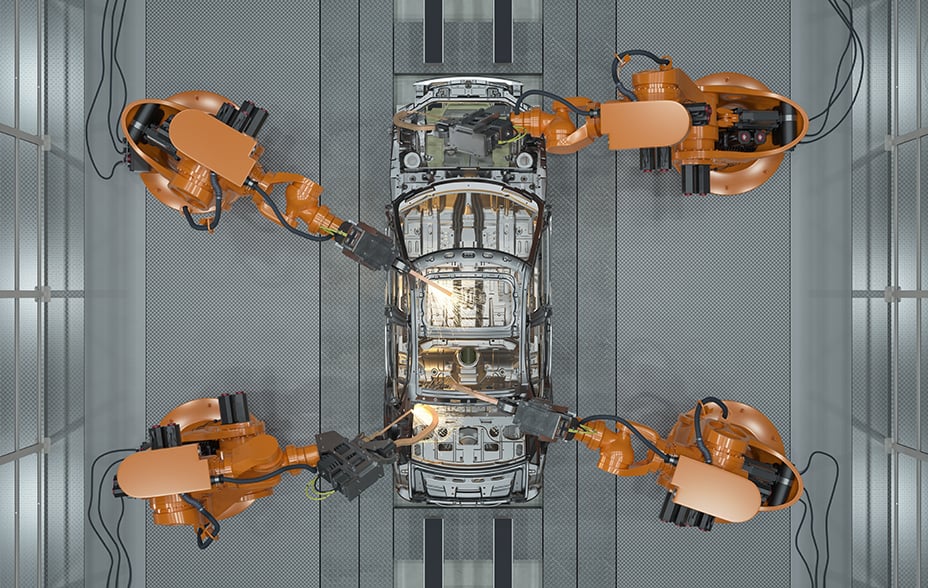
Over the last decade, growth has experienced unprecedented tailwinds, including globalisation, low-interest rates, and lots of 'change', such as in technologies, business models, and consumer demand. Some macro factors, including geopolitics and monetary policy, have become more challenging for growth companies, but change remains a very powerful growth driver.
We're optimistic that over the long term, we'll continue to see change reflected in substantial share price growth for the few companies that are most successful at harnessing it. There's lots of evidence to support this optimism.
As Joseph Schumpeter said, businesses and societies are in a constant state of innovation and transformation. According to Schumpeter, this process of "creative destruction" is a natural and essential element of capitalism, as it allows for the replacement of outdated technologies and business models with newer, more efficient ones. This process is driven by entrepreneurs, who introduce new products, services and technologies that disrupt existing markets and industries. Through creative destruction, new industries and markets emerge, and the economy and stock market are constantly in a state of evolution. In this way, Schumpeter argued that creative destruction is necessary for a healthy economy, as it helps to keep businesses and markets competitive and allows for innovation and growth.
| 1980 | 2000 | 2020 |
| IBM | General Electric | Apple |
| AT&T | Microsoft | Saudi Aramco |
| ExxonMobil | ExxonMobil | Microsoft |
| Amoco | Walmart | Amazon |
| Schlumberger | Citigroup | |
| Shell Oil | Pfizer | |
| Mobil | Intel | Tencent |
| Chevron | BP | Alibaba |
| Atlantic Richfield | Johnson & Johnson | Tesla |
| General Electric | Royal Dutch Shell | Berkshire Hathaway |
Source: Forbes, Fortune500, Ycharts, company's annual report. 10 of the largest companies by market cap.
Underpinning creative destruction, I argue, is the fact that humans are a species of perpetual innovation. Creative destruction is part of our very nature.
Humans, a species of innovation
Modern humans, or homo sapiens, evolved around 300,000 years ago in Africa and have since expanded onto nearly every type of climate and terrain on Earth. We're now comfortably the planet's apex species, and these days we're even dashing about in space. Impressive progress, for a once unremarkable primate.
Despite challenges throughout our history, including a near-extinction event about 70,000 years ago, humans have continued to progress far faster than other animals. To understand this, Charles Darwin's theory on the "natural selection of random mutations" explains how evolution has equipped us with physical, mental, and cultural characteristics that have allowed us to thrive.
Thanks to our evolutionary journey, humans possess a unique physicality and intelligence. Our abilities to accurately evaluate our environment, conceive of sophisticated ideas, and create tools, have led us to become a species of unparalleled problem solvers.
Another key aspect of our success is our curiosity, which has driven us to explore and invest in the future. For instance, our curiosity has often led us to diversify our food supplies; once, fortunately, in time for a climate emergency some 40,000 years ago. The same could not be said for our earlier evolutionary cousins, like Neanderthals and Denisovans, who consequently faced extinction. Embracing our curiosity allows us to address all sorts of challenges and seek new solutions.
Our sociability helps too. By working within societies and sharing knowledge, we've been able to tackle problems and expand our skills collectively, scaling up our individual achievements.

In the book Transcendence, Gaia Vince argues that our unique ability to determine our own destiny is due to a special relationship between our genes, environment, and culture that traces back into deep time. Our collective culture, rather than just our individual intelligence, makes humans unique.
Vince cites evidence that human progress rapidly increases when our populations become larger, better educated, and better connected. This is to do with the frequency and dissemination of good ideas.
Conversely, small and isolated human populations will progress much more slowly. Vince refers to Tasmanian Aboriginal communities, who, by the 18th century, had been isolated from the mainland for 10,000 years. The people there were struggling, with just 24 different tools, and they had lost the ability to make fire. Their isolation had "shrunk their collective brain". Compare this with the Pama-Nyungan-speaking Aboriginals living directly across the Bass Strait from Tasmania, who had hundreds of complex tools, boats, items of clothing and practices.
Let's consider humanity's population size, education and connectedness today.
Historically, our global population was slow to increase. It took until 1804 to reach one billion. However, largely due to advances in medicine and agriculture, our population has since grown rapidly. By 1927, it was two billion, and today it's around eight billion, showing a steep upward trend. The United Nations expects it to peak later this century at around 11 billion people.
Similarly, there has been rapid growth in global education standards in recent centuries. Through increased access to education, literacy rates have dramatically risen, from as low as 12 per cent in the 19th century to 86 per cent globally today. Global education in science, technology, engineering and maths has seen dramatic improvements too. The increase of research articles from around 1,000 annual publications in the early 18th century to over 2.5 million every year now, indicates a significant increase in knowledge production and dissemination. Technological advances have also improved traditional classroom frameworks.
Likewise, human connectedness was once limited by geography, but with technological advents in transportation and communication, global interconnectedness has risen dramatically. In the 20th century, the invention of the internet created an information revolution, allowing instant global communication. Today, there are five billion internet users worldwide, supporting our ever-increasing global connectedness.
Combining human physical and mental talents, with recent explosions in our population size, education and connectedness, it makes sense that our economic growth has exploded too.
Industrial revolutions and the opportunity for investors
As global populations become increasingly large, well-educated and well-connected, humanity's propensity for innovation has led to a series of industrial revolutions.
Source: World Economic Forum. The history of innovation cycles.
These industrial revolutions have included the harnessing of steam power, electricity, radio communications, internal combustion engines, flight, assembly lines, and computers.
We can easily understand how valuable these things have been. The WEF's economic 'waves of change' show that the compounding of generational knowledge means that each revolution is more valuable than the last.
From an investment perspective, it's important that we don't view these revolutions in isolation, rather, as escalating stages of humanity's ongoing saga of innovation.
The behavioural mechanism of industrial revolution is quite simple to describe. Industrial revolutions are born in moments of innovation that can be so genius that they border on irreverence, as Thomas Kuhn put it, thanks to our enormous brains. Such innovations are more likely to take place and spread as populations become larger, better educated, and better connected, as Vince put it. These innovations are subsequently picked up by curious and visionary business leaders who recognise the commercial value, as Schumpeter put it. Consumers rationally spend their money on the new and better offerings. Each generation of progress will support the next.
This process is very much alive in the world today and is key to understanding the opportunities we face as growth investors.
The modern phase of industrial revolution – our phase – is another highly valuable era of change. It's the coming together of technologies such as artificial intelligence (AI), gene editing and advanced robotics, which breakdown the barriers between the physical, digital and biological worlds.
For instance, the human genome was unlocked in 2003 by a series of prior innovations, such as Watson and Crick's discovery of the double-helix, Sanger's sequencing method, and the Human Genome Project's ambitious launch and completion. These breakthroughs have created entirely new industrial opportunities for healthcare, which a new generation of growth companies are seizing. Some of these we invest in. Moderna for instance, is a business that uses humanity's accumulated knowledge on genetics to build a new realm of treatments with messenger RNA. An astonishing paradigm shift. The European company Genmab is another pioneer. That company is making big leaps forward in immunotherapies for cancer.

© Genmab
The progress of innovation in renewable energy is another instance. Solar power is becoming much more efficient, and its rapid price deflation makes it increasingly attractive to consumers and investors. Other advancements include electricity distribution and storage, as batteries and other equipment come on leaps and bounds. It's expected that global electricity usage will double by 2035 and triple by 2050. The energy transition is therefore becoming an enormous economic opportunity. Our holdings SolarEdge, the Israeli solar inverters business, Vestas, the Danish wind turbines company, and Tesla, the US manufacturer of electric vehicles and static storage, are examples of renewables innovation being taken forward commercially.
The nature of returns
Let's first remind ourselves that equity returns are highly asymmetric. All decisions about equity investing should be made with this in mind. Of the 60,000 listed companies globally between 1990-2018, only 1.5 per cent of them created all the net wealth above T-bills – $45tn worth. To own these big winners, you can either invest passively, in which case you're guaranteed to own them but also to dilute your returns with the 98.5 per cent of the market that equates to T-bills; or you can back a stock picking process that aims to invest in just the biggest winners, in which case your returns can be exceptional.
One stock picking approach is to look for the few businesses driving valuable change.
The link between change and potentially outsized returns is the intuitive combination of two facts: 1) consumers prefer to spend their money on new and improved products and services (compare your cell phone of today with that of 20 years ago), and 2) a company's profits drive its share price over the long term. The MSCI ACWI is worth over $60tn today, but most of the thousands of companies it consists of are being disrupted by a few innovators. Here is a big opportunity for investors.
Change does not come free. Bringing about real-world change is more than just a thought-experiment. It's about investment and hard work. Spending on research and development is equivalent to taking risk with the potential for future rewards.
Innovative companies also require a lot of patience. Rome was not built in a day. Likewise, Henry Ford's mass-production assembly lines were not built in a day, and neither were ASML's ground-breaking machines for semiconductor production. The best performing long-term stocks are also often the most volatile over the short term, so we need to be patient.
Humans are not naturally good at being patient, though. The same evolutionary journey that made us good at innovation has conversely made us quite impatient. For most of our existence, we were hunter-gatherers and had to think in terms of seasons. About 12,000 years ago we became farmers, and our perspective was pushed out to a few years. While the modern industrial era, with our longer life expectancies, requires us to plan over time horizons of decades, this era accounts for just 0.1 per cent of our time as a species. Patience is not hard-wired into us.
We can see humanity's impatience writ large on the stock market, where the average holding period for a company is less than a year – nowhere near long enough for a company’s competitive advantages to turn into substantial growth.
The best solution for this is institutional patience. Business leaders need to instil a long-term perspective into company culture. This includes investment firms, because in spite of the challenges, owning transformational growth companies can be extremely rewarding when it results in significant share price growth. The long tail of positive outcomes for companies allocating more capital to growth, versus returning cash to shareholders, shows that these companies can benefit from investing in innovation.
Take Intel in the 1970s as one example. The 70s were really tough economically: armed conflicts, oil crises, inflation, unemployment, slow economic growth, and struggles transitioning from manufacturing to service-based economies. But Intel's share price grew nearly 20 times during that troubled decade. This was achieved through creative destruction. Intel recognised the forthcoming revolution in personal computing, it invested heavily to create its fantastic 8080 and 4004 microprocessors, it grew its profits rapidly, and the share price followed suit.
I chose a 50-year-old example because it is analogous with today. The 2020s’ macro environment has become more challenging, but change remains a powerful growth driver today, thanks to our generation's industrial revolution.
Interestingly, due to a lack of investment, Intel has now ceded ground to another disruptive growth company, Taiwan Semiconductor Manufacturing Co, which spends heavily and patiently to lead the field. The deep cycle of creative destruction continues.
Innovative companies need capital, time and supportive shareholders to realise their potential, but the rewards can be profound, whatever the economic weather.
The power of our tools
Tens of thousands of years ago, we were presumably proud of our stone axes and flint spears. Rightly so, as the mere creation of tools is an astonishing feat in the animal kingdom. Excavations of ancient burial sites reveal tools clutched in the hands of our ancestors, and they are depicted in cave paintings. Those early tools meant a lot to us.
Fast-forward to the modern age. Will I be buried with my smartphone in my hand? I hope not, but our tools have come a long way and they continue to astonish.

Think of the economist Brian Arthur defining “combinatorial evolution” as new technological combinations arising out of the collection of previous ones; the engineer Gordon Moore accurately foretelling decades of progress in computing power; the aforementioned philosopher Thomas Kuhn describing the structure of paradigm-shifting scientific revolutions; the development specialist Carlota Perez explaining how combinations of capital and science can create enormous value; and the futurist Ray Kurzweil optimistically predicting our species’ further evolution through AI.
Power laws occur when human ingenuity and scalable technologies are combined. We at Baillie Gifford have been investing in this fact for over a century.
What is most exciting for us about the modern industrial revolution is the sheer scalability of it. We expect enormous demand for things like accelerated computing, AI, drones, clean technology, and biological technology, to name but a few. Today's industrial revolution is underway and it is astonishing. As investors, we need to be patient.
Let us conclude with another combination of two facts. 1) Change – such as in technologies, business models, and consumer demand – can be an exceptionally powerful growth driver, and 2) change is a part of human nature. Hence, the opportunities we face as growth investors are as exciting as ever.
Risk factors
The views expressed should not be considered as advice or a recommendation to buy, sell or hold a particular investment. They reflect opinion and should not be taken as statements of fact nor should any reliance be placed on them when making investment decisions.
This communication was produced and approved in August 2023 and has not been updated subsequently. It represents views held at the time of writing and may not reflect current thinking.
Potential for Profit and Loss
All investment strategies have the potential for profit and loss, your or your clients’ capital may be at risk. Past performance is not a guide to future returns.
This communication contains information on investments which does not constitute independent research. Accordingly, it is not subject to the protections afforded to independent research, but is classified as advertising under Art 68 of the Financial Services Act (‘FinSA’) and Baillie Gifford and its staff may have dealt in the investments concerned.
All information is sourced from Baillie Gifford & Co and is current unless otherwise stated.
The images used in this communication are for illustrative purposes only.
Important information
Baillie Gifford & Co and Baillie Gifford & Co Limited are authorised and regulated by the Financial Conduct Authority (FCA). Baillie Gifford & Co Limited is an Authorised Corporate Director of OEICs.
Baillie Gifford Overseas Limited provides investment management and advisory services to non-UK Professional/Institutional clients only. Baillie Gifford Overseas Limited is wholly owned by Baillie Gifford & Co. Baillie Gifford & Co and Baillie Gifford Overseas Limited are authorised and regulated by the FCA in the UK.
Persons resident or domiciled outside the UK should consult with their professional advisers as to whether they require any governmental or other consents in order to enable them to invest, and with their tax advisers for advice relevant to their own particular circumstances.
Financial intermediaries
This communication is suitable for use of financial intermediaries. Financial intermediaries are solely responsible for any further distribution and Baillie Gifford takes no responsibility for the reliance on this document by any other person who did not receive this document directly from Baillie Gifford.
Europe
Baillie Gifford Investment Management (Europe) Limited provides investment management and advisory services to European (excluding UK) clients. It was incorporated in Ireland in May 2018. Baillie Gifford Investment Management (Europe) Limited is authorised by the Central Bank of Ireland as an AIFM under the AIFM Regulations and as a UCITS management company under the UCITS Regulation. Baillie Gifford Investment Management (Europe) Limited is also authorised in accordance with Regulation 7 of the AIFM Regulations, to provide management of portfolios of investments, including Individual Portfolio Management (‘IPM’) and Non-Core Services. Baillie Gifford Investment Management (Europe) Limited has been appointed as UCITS management company to the following UCITS umbrella company; Baillie Gifford Worldwide Funds plc. Through passporting it has established Baillie Gifford Investment Management (Europe) Limited (Frankfurt Branch) to market its investment management and advisory services and distribute Baillie Gifford Worldwide Funds plc in Germany. Similarly, it has established Baillie Gifford Investment Management (Europe) Limited (Amsterdam Branch) to market its investment management and advisory services and distribute Baillie Gifford Worldwide Funds plc in The Netherlands. Baillie Gifford Investment Management (Europe) Limited also has a representative office in Zurich, Switzerland pursuant to Art. 58 of the Federal Act on Financial Institutions (‘FinIA’). The representative office is authorised by the Swiss Financial Market Supervisory Authority (FINMA). The representative office does not constitute a branch and therefore does not have authority to commit Baillie Gifford Investment Management (Europe) Limited. Baillie Gifford Investment Management (Europe) Limited is a wholly owned subsidiary of Baillie Gifford Overseas Limited, which is wholly owned by Baillie Gifford & Co. Baillie Gifford Overseas Limited and Baillie Gifford & Co are authorised and regulated in the UK by the Financial Conduct Authority.
China
Baillie Gifford Investment Management (Shanghai) Limited 柏基投资管理(上海)有限公司(‘BGIMS’) is wholly owned by Baillie Gifford Overseas Limited and may provide investment research to the Baillie Gifford Group pursuant to applicable laws. BGIMS is incorporated in Shanghai in the People’s Republic of China (‘PRC’) as a wholly foreign-owned limited liability company with a unified social credit code of 91310000MA1FL6KQ30. BGIMS is a registered Private Fund Manager with the Asset Management Association of China (‘AMAC’) and manages private security investment fund in the PRC, with a registration code of P1071226.
Baillie Gifford Overseas Investment Fund Management (Shanghai) Limited柏基海外投资基金管理(上海)有限公司(‘BGQS’) is a wholly owned subsidiary of BGIMS incorporated in Shanghai as a limited liability company with its unified social credit code of 91310000MA1FL7JFXQ. BGQS is a registered Private Fund Manager with AMAC with a registration code of P1071708. BGQS has been approved by Shanghai Municipal Financial Regulatory Bureau for the Qualified Domestic Limited Partners (QDLP) Pilot Program, under which it may raise funds from PRC investors for making overseas investments.
Hong Kong
Baillie Gifford Asia (Hong Kong) Limited 柏基亞洲(香港)有限公司 is wholly owned by Baillie Gifford Overseas Limited and holds a Type 1 and a Type 2 license from the Securities & Futures Commission of Hong Kong to market and distribute Baillie Gifford’s range of collective investment schemes to professional investors in Hong Kong. Baillie Gifford Asia (Hong Kong) Limited
柏基亞洲(香港)有限公司 can be contacted at Suites 2713–2715, Two International Finance Centre, 8 Finance Street, Central, Hong Kong. Telephone +852 3756 5700.
South Korea
Baillie Gifford Overseas Limited is licensed with the Financial Services Commission in South Korea as a cross border Discretionary Investment Manager and Non-discretionary Investment Adviser.
Japan
Mitsubishi UFJ Baillie Gifford Asset Management Limited (‘MUBGAM’) is a joint venture company between Mitsubishi UFJ Trust & Banking Corporation and Baillie Gifford Overseas Limited. MUBGAM is authorised and regulated by the Financial Conduct Authority.
Australia
Baillie Gifford Overseas Limited (ARBN 118 567 178) is registered as a foreign company under the Corporations Act 2001 (Cth) and holds Foreign Australian Financial Services Licence No 528911. This material is provided to you on the basis that you are a ‘wholesale client’ within the meaning of section 761G of the Corporations Act 2001 (Cth) (‘Corporations Act’). Please advise Baillie Gifford Overseas Limited immediately if you are not a wholesale client. In no circumstances may this material be made available to a ‘retail client’ within the meaning of section 761G of the Corporations Act.
This material contains general information only. It does not take into account any person’s objectives, financial situation or needs.
South Africa
Baillie Gifford Overseas Limited is registered as a Foreign Financial Services Provider with the Financial Sector Conduct Authority in South Africa.
North America
Baillie Gifford International LLC is wholly owned by Baillie Gifford Overseas Limited; it was formed in Delaware in 2005 and is registered with the SEC. It is the legal entity through which Baillie Gifford Overseas Limited provides client service and marketing functions in North America. Baillie Gifford Overseas Limited is registered with the SEC in the United States of America.
The Manager is not resident in Canada, its head office and principal place of business is in Edinburgh, Scotland. Baillie Gifford Overseas Limited is regulated in Canada as a portfolio manager and exempt market dealer with the Ontario Securities Commission ('OSC'). Its portfolio manager licence is currently passported into Alberta, Quebec, Saskatchewan, Manitoba and Newfoundland & Labrador whereas the exempt market dealer licence is passported across all Canadian provinces and territories. Baillie Gifford International LLC is regulated by the OSC as an exempt market and its licence is passported across all Canadian provinces and territories. Baillie Gifford Investment Management (Europe) Limited (‘BGE’) relies on the International Investment Fund Manager Exemption in the provinces of Ontario and Quebec.
Israel
Baillie Gifford Overseas is not licensed under Israel’s Regulation of Investment Advising, Investment Marketing and Portfolio Management Law, 5755–1995 (the Advice Law) and does not carry insurance pursuant to the Advice Law. This material is only intended for those categories of Israeli residents who are qualified clients listed on the First Addendum to the Advice Law.
Ref: 57509 10031542





